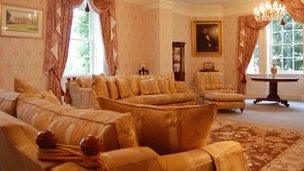House prices: A tale of £2m properties
- Published

Six-bedroom Loynton Hall stands in 12.5 acres of land in rural Staffordshire
Looking out the snooker room window across the lush green grounds of up-for-sale Loynton Hall, it is hard to imagine that a one-bedroom city flat could fetch more from buyers.
Yet offers have already been turned down at higher values for the apartment tucked into the ground floor of a Regency building in Notting Hill, west London.
The tale of these £2m properties tells the story of supply and demand during the worst of times - a recession - and of geographical differences in UK house prices.
It also sheds a light on the £2m-plus residential market as the government starts to levy a new 7% rate of stamp duty.
'Selling a lifestyle'
A total of 96 homes were sold in England and Wales for more than £2m in February, according to the latest Land Registry figures. Of these, only 15 were outside London.

Portraits of the Higgin Burne family hang in the drawing room
Another 104 were sold at £1.5m to £2m. Of these, 37 were outside the capital.
The owners of Loynton Hall, a six-bedroom Georgian country house in rural Staffordshire, have put their home on the market at a guide price of £2m.
Strolling up the sweeping driveway, only the sound of shoes on gravel interrupts the tranquil soundtrack of birdsong from the trees and bushes near the adjacent fishery.
"We are selling a lifestyle as much as a property," says Tony Morris-Eyton, the northern region head of estate agent Savills.
Potential buyers seem to hold the same view, with some asking about the possibility of constructing a tennis court within the grounds, and others attracted to the integral granny flat for family or staff.
Step through the front door between Doric columns and history drips from the building - from the portraits, hung in the drawing room, of the Higgin Burne family who built the house in about 1671, to the traditionally fitted kitchen complete with Aga.
With good schools nearby, it is mostly families who have been to viewings of the property.
Eurozone crisis
However attractive the proposition, the market for properties of all values in Staffordshire is patchy and often difficult, according to Mr Morris-Eyton.
Prices dropped year-on-year by 2.3% in the county on average in April, Land Registry statistics show. This was a greater fall than the national annual average fall of 1%.
There is uncertainty about the future of the housing market, caused partly by the upheaval in the eurozone.
This unpredictability on the continent is having the opposite effect in London, just an hour and 20 minutes away on the railway mainline. Prices have remained buoyant owing to the interest of international buyers.
"There seem to be an endless flow of wealthy Greek buyers - old Greek family money - coming to London, both renting and buying," says Noel de Keyzer of Savills.
Instead of cooling since the Budget, the prime central London market continues to attract international and domestic buyers as a "safe haven", the estate agent says.
This is despite Chancellor George Osborne's decision to add a new layer of stamp duty, levying 7% for properties sold for more than £2m.
Stamp duty on residential properties over £2m bought via a company also increased to 15%, and overseas companies that already own UK residential property worth more than £2m will be subject to capital gains tax from April 2013.
'Trophy address'
There is already some disagreement within the property industry as to the effect of the policy on house prices.

The one-bedroom flat in Kensington Park Gardens is on the market for £2.2m
Some, such as Mark Harris, chief executive of mortgage broker SPF Private Clients, argue that it has created an "artificial" boundary at certain values. At £2,000,000, the stamp duty is charged at 5% of the selling price; at £2,000,001 the tax is charged at 7%.
"'There is no longer a market for properties priced at between £2m and £2.1m, and almost to somewhere around £2.25m," he says.
"Vendors pricing at this level will struggle to sell, and may well find that they have to reduce the property price to just under £2m in order to find a buyer.
"For a £2.1m sale, the stamp duty is £147,000 as opposed to £100,000 for a £2m purchase."
Others say that properties on sale at prices just above the stamp duty thresholds prompt negotiations between buyer and seller.
But Ed Mead, director at Douglas and Gordon estate agents, says that the extra £47,000 is irrelevant for some people with more than £2m to spend on property in central London.
The capital's housing market, where demand for high-value properties remains strong and supply remains restrained, is striking in its difference to the rest of the country.
In April, one property was registered with the Land Registry as being sold for £55m.

Location, rather than size, sets prices for some properties in London's most expensive areas
The unique market is also why a one-bedroom flat in Notting Hill can go onto the market for £2.2m.
Mr Mead describes the property as a "trophy address".
"You can't get a much better location," he says, looking out towards the private garden for residents.
The high ceilings, spacious living room and conservatory are a draw but, with five fewer bedrooms than Loynton Hall, he accepts that it is an "indulgent" purchase.
Yet it is also an investment, he argues.
Prices in the borough of Kensington and Chelsea have risen by 11.6% in the 12 months to the end of April, Land Registry statistics show. The average house price in the borough has now risen just above £1m.
So the image of a millionaire's mansion can shrink from a country house to a downstairs flat. It is for buyers to decide whether it is size or location that matters.